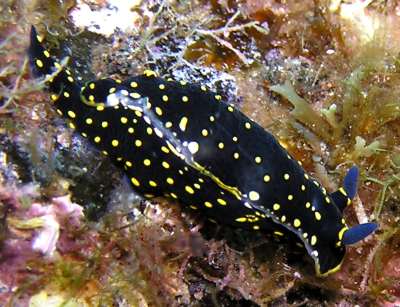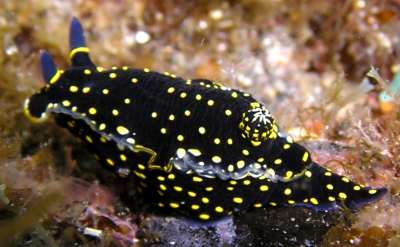

Hypselodoris picta azorica
Ortea, Valdés & García-Gómez, 1996
Order: NUDIBRANCHIA
Suborder: DORIDINA
Superfamily: EUDORIDOIDEA
Family: Chromodorididae
DISTRIBUTION
Known only from the Azores.
PHOTO
Faial island, Azores, Portugal. Depth: 8 m. 9 August 2005. Photographer: David Abecasis
RELATED TOPIC
The animal has a deep purple to black background colour with yellow or orange spots scattered over the mantle and the sides of the body. The density of spots variesfrom quite sparse to very crowded. There is also a yellow line bordering the mantle which differs in thickness in different specimens, and can be at times broken. There is a yellow border to the raised rhinophore pockets and a thin yellow line around the gill pocket and as series of yellow spots. The rhinopores are usualy translucent purple with a deeper blue tip, but in the animal illustrated here the whole of the rhinophore is blue. The gills are triangular in outline. They are translucent purple with a blue outer face edged with rows of yellow spots. The inner edge of each gill has a thin yellow line.
This subspecies is known only from the Azores.
Ortea, Valdes & Garcia-Gomez (1996) named this colour form Hypselodoris picta azorica subespecie nueva but they have not followed normal accepted nomenclatural practice so I doubt if the name is valid. To validly name a subspecies they should have followed the same rules as apply to naming a species, such as characters that differentiate the species from related species and allocating a type specimen. It is important to designate type specimens so that if later there are problems in identifying the species (or subspecies) there is a reference specimen we can go back to. This is specially important in groups, like the chromodorids, where we have so many problems in separating similarly coloured species - like the blue ones in the Mediterranean. This subspecies appears to lack yellow lines, but so do some 'typical' H. picta picta.
-
Ortea, J., Valdés, A. & and García-Gómez, J.C. (1996) Revisión de las especies atlánticas de la familia Chromodorididae (Mollusca: Nudibranchia) de grupo cromático azul. [Review of the Atlantic species of the family Chromodorididae (Mollusca: Nudibranchia) of the blue chromatic group.] Avicennia, 1996, Suppl. 1: 1-165.
Rudman, W.B., 2005 (September 13) Hypselodoris picta azorica Ortea, Valdés & García-Gómez, 1996. [In] Sea Slug Forum. Australian Museum, Sydney. Available from http://www.seaslugforum.net/find/hypsazor
Related messages
Hypselodoris picta 'azorica' from the Azores
September 13, 2005
From: David Abecasis


Hello!
These photos were taken in the Azores islands. Are they Hypselodoris picta azorica? Is there such subspecies and how can I identify it?
Locality: Faial island, Azores, Portugal. Depth: 8 m. 9 August 2005. Photographer: David Abecasis
Thanks a lot!
David Abecasis
davidbecas@netcabo.pt
Abecasis, D.A., 2005 (Sep 13) Hypselodoris picta 'azorica' from the Azores. [Message in] Sea Slug Forum. Australian Museum, Sydney. Available from http://www.seaslugforum.net/find/14742
Dear David,
This raises an interesting nomenclatural point. It certainly seems to be the animal which Ortea, Valdes & Garcia-Gomez (1996) call Hypselodoris picta azorica but they have not followed normal accepted nomenclatural practice so I doubt if the name is valid. To validly name a subspecies they should have followed the same rules as apply to naming a species, including allocating a type specimen. I assume your animal is just a very dark colour form of H. picta azorica, because in all the other photos I have seen of it, the background colour is purple and there is a yellow border around all of the mantle edge. The reason it is important to designate type specimens is so if later there are problems in identifying the species (or subspecies) there is a reference specimen we can go back to. This should be very obvious to anyone working with chromodorids, where we have so many problems in separating similarly coloured species - like the blue ones in the Mediterranean.
Apart from the black background colouration your animal seems to match other aspects of this subspecies's colour pattern which I summarise on the Fact Sheet.
Best wishes
Bill Rudman
